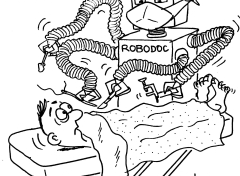Medical sciences being the most necessary study of human life are becoming more of technological sciences. Improvements and modifications are being taken up by professionals, engineers, doctors to sustain human longevity and to develop good behaviors. One of the notable introductions brought in medicine is the Robotic Surgery. The robotic or robot-assisted surgery is the method of doing operations with the help and experience of doctors through robots. These medical robots use four arms to do the surgical procedure in a more technical and advanced way. These robots are doing a great job in the “minimally invasive surgery,” which means producing lesions that are smaller and gives fewer pain sensations.
IMPORTANCE OF ROBOTIC SURGERY:
- The patient experiences less pain and trauma in his or her body in this procedure as compared to normal operation.
- As said earlier, the lesions, markings, and lesions are minimally made when completed through robots.
- The time of a patient’s recovery is quicker from these operations.
- Infections and other bacterial pathogens are in reduction as there is no open cutting or wound.
- Every arm of the robot is designed with its respective jobs, so this reduces doctor’s tension and fatigue during surgeries.
TECHNOLOGY BEHIND ROBOTIC SURGERY:
Da Vinci Si- the most advanced robot at recent times has four arms which are fixed with various instruments needed for the operation. The fourth arm of the robot has a camera which will be magnified to a larger dimension with high quality to make the procedure simpler. The clinician keeps his or her hands in the controllers of the robot’s arm and moves in accordingly so with the camera simultaneously. The surgery may be shifted further through the observations from the stereoscopic high-definition monitor and due to full viewing and clear consoles the doctor can handle the situation more suitably. The doctor can even move the entire arms of the robot to his or her needs. This way the surgeon can go deep into the patient’s body and cure or treat them. The unprecedented controls and relaxed state of surgery are advantageous for both the patient and the surgeon.

Few SURGERIES THAT USE ROBOTS:
- Robotic cancer operations
- Robotic surgery for gynecology
- Robotic Urology
- Robotic spine surgery
- Robotic colorectal surgery
- Robotic Cyst Decortication
- Robotic Nephroureterectomy
- Robotic Sacrocolpopexy
DANGERS OR THREATS BEHIND ROBOTS IN SURGERY:
Efficiency and feasibility behind this new technology of robotic surgery are still questionable since no long-term follow-up studies are in view at times. Prohibitive costs of robots doing surgery are not up to the budget for middle or low-class families. Regular updating must be necessarily done to ensure a smooth running of robots for operations. Lack of compatible instruments is a big drawback since this is a new invention and substitute kits are to be produced then and there. A local injury due to a robot in the procedure affects the patient with either as side-effects or may harm the operation directly. Henceforth, the challenge is to seek up proper medial aids and tools that will make the traditional medical procedures and a robotic surgery the same.



















